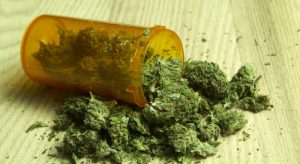“That is not a drug, it’s a leaf.”
– Arnold Schwarzenegger

In the next few years, two of the many areas that could be interesting areas of medical research and therapy may be the the fields of cancer immunotherapy and the medical use of cannabinoids. Yes, cannabinoids – those extracts from cannabis aka marijuana aka weed!
No other plant is as controversial as Cannabis. In spite of an almost 5000 year-old history of use around the world, it has been a banned substance in most countries in the last 100 years or so.
It’s ill-repute stems from it’s psychoactive effects which can be significant.
Some of the chemicals inherent in the most common species of this plant, Cannabis sativa, have been isolated and they are called cannabinoids. There are about 85 of them. The two most researched are:
– Delta-9 Tetrahydrocannabinol (THC) and
– Cannabinol (CBD)
Whereas THC is responsible for most of the psychoactive effects (the high), CBD has none of the high effect. Both cannabinoids have some very significant therapeutic effects.
THC – analgesic, anti-spasmodic, anti-tremor, anti-inflammatory, appetite stimulant and anti-emetic
CBD – anti-inflammatory, anti-convulsant, anti-psychotic, anti-oxidant, neuroprotective and immunomodulatory effects
Even more interesting is that the human body has cannabinoid receptors. This has been an area of research for the last 20 years or so. Two types of cannabinoid receptors have been found so far – CB1 and CB2. CB1 receptors are present in the brain and spinal cord and in certain peripheral tissues. CB2 receptors are expressed primarily in immune tissues.
Now if the body has cannabinoid receptors, then humans must produce natural cannabinoids. At least 3 have been isolated so far – arachidonoyl-ethanolamide (anandamide), 2-arachidonoyl glycerol (2-AG) and arachidonyl glyceryl ether (noladin ether).
These endocannabinoids are involved in areas of the brain responsible for:
– movement and postural control, pain and sensory perception, memory, cognition, emotion,
control and reward centers in the brain (limbic system and hypothalamus)
– cytokine release from immune cells and immune cell migration
So when one uses marijuana, do the cannabinoids from the weed react with the natural receptors? That is the thought and that is how they exert their action.
The push is then for strains of Cannabis high in CBD to capture the medicinal sans psychoactive effects. This is achieved by altering the genome of the cannabis plant to get strains that contain mostly CBD. An example of a strain with high levels of CBD is Charlotte’s Web.
In the forefront for drugs made out of CBD is GW Pharma, a company out of the London, UK. They have a drug out named Epidiolex for Dravet Syndrom. This a condition marked by intractable seizures in kids. These kids can have over 20 seizure a month. It reduced the incidence of seizures in a study of 120 children by close to 40%. FDA approval is pending.
CBD-based drugs are also being studied for Multiple Sclerosis. It reduces the incidence and severity of muscle and bladder spasms as well as the intensity of neuropathic pain.
CBD has been shown to reduce the incidence of psychosis in Schizophrenics and may modulate symptoms of fear in patients with PTSD.
CBD has been shown to be very effective in the treatment of chronic pain with a much safer safety profile than opioids.
There are a few studies out showing the cytotoxic effects of CBD on breast cancer cells.
All these examples are but a few of the therapeutic possibilities being researched actively.
CBD however still remains a Schedule I substance and thus viewed as illicit when used without a prescription or in a state where the use of marijuana is not legal.
Maybe Bob Marley was right after all:
“Herb is the healing of a nation, alcohol is the destruction.”
